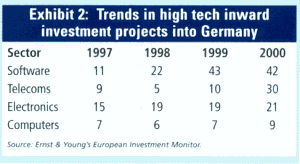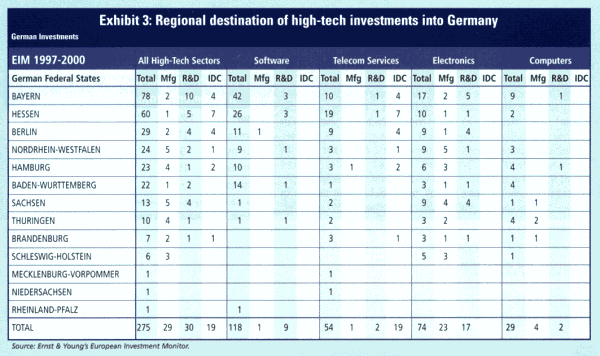G |
ermany is the economic powerhouse of Europe. It has a highly educated population, registers a high percentage of European patents and overall presents an interesting proposition to high tech-inward investors.
 However, despite recent changes in taxation, the well-known problems relating to structural rigidities in the economy, in particular labor markets, have meant that Germany under-performs in inward investment.
However, despite recent changes in taxation, the well-known problems relating to structural rigidities in the economy, in particular labor markets, have meant that Germany under-performs in inward investment.From a sectoral point of view, the Ernst & Young European Investment Monitor (EIM) has tracked investments in high-tech (software, telecom services, computers and electronics) into Europe since 1997. Based on an analysis of EIM results, software and telecom services projects into Germany have been increasing and Germany has been holding its own in electronics and computer projects. In Internet data centers, Germany is well ahead of other countries.
Within Germany, most higher value-added projects (R&D) have been going toward the traditional clusters in Bavaria (mainly Munich) and Hessen (Frankfurt), as well as Berlin. North Rhine Westphalia and Saxony have been strong in high-tech manufacturing. This differentiation has been largely cost driven.
Over the period of 1997 to 2000, Dublin, Stockholm and Sophia Antipolis lead other European cities on the services side. In manufacturing, Budapest, Cork, Livingston, Telford and Barcelona lead Munich and Frankfurt.
In short, Germany is not realizing its potential in inward investment in the high- tech sector. Lessons can be learned from the fundamental changes the United Kingdom had to go through in the 1980s and the long-term efforts in industrial development and promotion by the Scots, Irish and French (e.g., Sophia Antipolis).
UK Leads Europe in Inward Investment
 From an economic point of view, Germany is by far the largest player in the EU, as exhibit 1 indicates.
From an economic point of view, Germany is by far the largest player in the EU, as exhibit 1 indicates.
With these credentials, Germany would seem to be set for a powerful performance in EU high-tech inward investment projects (high-tech defined as electronics, software, telecom services and computers). Ernst & Young’s European Investment Monitor has tracked the number of announced projects going into the various states of Europe since 1997. Analysis of this database has produced the following results.
Looking at all projects within these high-tech sectors over the period of 1997 to 2000 from a pan-European point of view, the UK has a substantial lead over No. 2 France and No. 3 Germany.
The UK’s overall lead in inward investment into Europe is the result of language/culture and policy. It must be remembered that in the late 1970s, the gap between the UK and Germany as recipients of US inward investment was rapidly narrowing. It was as a result of changes in UK policy in the late 1970s and early 1980s that the UK was able to re-establish and increase its lead over Germany. Maybe Germany can respond.
In exhibit 2 sectoral trends are summarised. In software there has been a definite upward shift, as in telecoms. In electronics and computers it has been difficult for Germany to maintain its position due to the competition from Eastern Europe, especially Hungary, for lower cost sites.
Regional Trend: Bavaria Garners R&D
Exhibit 3 sets out the regional destinations of high-tech investments into Germany.
As can be expected, most projects have gone to wealthy Bavaria, which has been particularly strong in software and electronics R&D, as well as IDCs. Hessen (where Frankfurt is located) has won projects in software R&D and been particularly successful in attracting IDCs, possibly linked to the developments in the financial sector in that region; Berlin has won electronics R&D projects and IDCs. North Rhine-Westphalia has been strong in electronics manufacture and R&D. Saxony has won electronics manufacturing projects.
There does seem to be a clear distinction between Bavaria (and to an extent Hesse and Berlin) and the rest, with the former regions being stronger in R&D and the latter in manufacture. This distinction is largely based on traditional regional specialization based on cost differentials.
Looking at the EIM analysis for the period from 1997 to 2000 as a whole, on a pan-European city basis, some interesting results emerge:
- Electronics: Stockholm leads the way with 10 R&D projects, followed by Sophia Antipolis with eight and Cork with four. Munich comes in at three. In electronics manufacture, Budapest leads with nine, Livingston comes in at seven and Cork and Barcelona have six each.
- In software R&D projects, Dublin leads with 27 projects, followed by Sophia Antipolis with 14 and Belfast with 11. Munich comes in at three and Frankfurt with two, trailing Stockholm with eight.
- Telecom services: Here there is not such a great spread of results in R&D. Frankfurt leads with IDCs (seven) and Munich has four. Paris and Barcelona come in at six, and London and Amsterdam have five each.
- Computers: Dublin leads both in R&D and manufacture (three and seven, respectively), with Telford making a strong showing in manufacture.
These figures suggest that Germany is not pulling its weight in terms of high-tech inward investment. There are probably two kinds of reasons for this:
First, Germany is actually driving investment into the rest of the EU, rather than the other way around. This is reflected in high-tech as well as other sectors. Although some changes in corporate taxation have recently been made in Germany, there are still rigidities in the economy, especially in labor markets, that have to be addressed before Germany will become really attractive to foreign investors.
Secondly, the highly focused and well-resourced promotional campaigns of other competitors such as Sweden, as well as the effect of some long-term efforts such as those of the Irish, the Scots at Livingston and the French in Sophia Antipolis, are bearing results.


